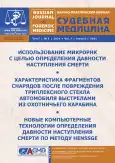Closed craniocerebral injury formation according to an indirect mechanism: a case from expert practice
- 作者: Ulyankin V.E.1, Kupriyanov A.Y.2, Zyubina E.A.1, Machinsky P.A.1
-
隶属关系:
- Ogarev Mordovia State University
- Republican Bureau of Forensic Medical Expertise
- 期: 卷 7, 编号 3 (2021)
- 页面: 168-171
- 栏目: 临床病例报告
- URL: https://journals.rcsi.science/2411-8729/article/view/122444
- DOI: https://doi.org/10.17816/fm380
- ID: 122444
如何引用文章
全文:
详细
Background: Approximately, 50 thousand die (i.e., about 10%) out of the 600 thousand people with a head injury. Literature examples reported some cases with brain damage with membranes in closed craniocerebral trauma formed by an indirect mechanism without direct contact of blunt solid objects in the head, which is characteristic of impulse trauma. Case presentation: In our practice, an unusual case of an indirect closed craniocerebral trauma with a fatal outcome resulting from a road traffic accident was encountered. The forensic medical examination of the corpse established a traumatic brain injury that formed without direct contact with blunt solid objects in the head. Traumatic brain injury formation by an impulse mechanism is rare in forensic medical practices; therefore, each case of such an injury is of certain interest, both in practical and scientific terms.
Conclusion: The impulse mechanism of head trauma, combined with the shock mechanism in road traffic accidents, is much more common than is currently believed. The bleeding source in such cases is often the venous vessels of the cerebral hemispheres, which flow into the sagittal sinus of the dura mater.
作者简介
Vladislav Ulyankin
Ogarev Mordovia State University
编辑信件的主要联系方式.
Email: Yliankin@yandex.ru
ORCID iD: 0000-0003-2695-3267
SPIN 代码: 2191-6740
Assistant
俄罗斯联邦, 7A Vasenko str., 430001, SaranskAlexey Kupriyanov
Republican Bureau of Forensic Medical Expertise
Email: kuper.lescha@yandex.ru
MD
俄罗斯联邦, 7A Vasenko str., 430001, SaranskEkaterina Zyubina
Ogarev Mordovia State University
Email: francekatusha@yandex.ru
Student
俄罗斯联邦, 7A Vasenko str., 430001, SaranskPetr Machinsky
Ogarev Mordovia State University
Email: KSudMedinfo@yandex.ru
ORCID iD: 0000-0003-0574-5768
SPIN 代码: 4536-4263
MD, Cand. Sci. (Med.), Associate Professor
俄罗斯联邦, 7A Vasenko str., 430001, Saransk参考
- Clinical guide to traumatic brain injury. Ed. by A.N. Konovalov, L.B. Lichterman, A.A. Potapov. Vol. III: Consequences and complications of traumatic brain injury, standards and recommendations, neurorehabilitation, examination. Moscow: Antidor; 2002. Р. 572–593. (In Russ).
- Lihterman LB, Potapov AA, Klevno VA, et al. Aftereffects of head injury. Russian Journal of Forensic Medicine. 2016;2(4): 4–20. (In Russ). doi: 10.19048/2411-8729-2016-2-4-4-20
- Grebenkov AB. Forensic medical examination of traumatic brain injury: reference and information materials. Kursk: Bureau of SME; 2014. 73 p. (In Russ).
- Nedugov GV. Subdural hematomas. Samara: Ofort; 2011. 343 p. (In Russ).
- Lichterman LB. Classification of cranial trauma. Part II. Modern principles of classification of traumatic brain injury. Russian Journal of Forensic Medicine. 2015;1(3):37–48. (In Russ). doi: 10.19048/2411-8729-2015-1-3-37-48
补充文件







